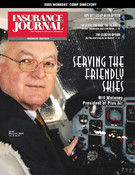The recent $190 million settlement between the world’s second largest insurance broker, Aon, and officials in three states sheds light on how, as New York Attorney General Eliot Spitzer and other public officials previously warned, their insurance investigations are not confined to commercial risks.
The civil complaint and exhibits filed by Spitzer along with the settlement agreement in a Manhattan courthouse describe Aon’s arrangements with Chubb and Fireman’s Fund to give those companies first right of refusal on high-end personal lines business. In return, the two insurers paid bonuses to Aon and helped pay as much as 50 percent of the salaries of some Aon producers.
According to the documents, Chubb funded 50 percent of salary and benefits for certain Aon personal lines brokers from 1999 to 2001. Chubb even helped pick some of these Aon employees, the complaint indicates. Aon also accepted producer funding from Fireman’s Fund Insurance Co. in 1999 and 2001 to cover 50 percent of the pay for up to 15 Aon producers, the complaint continues.
According to a 2001 e-mail from Carter Brydon, former managing director of Aon Private Risk Management unit through which the broker sells its personal lines policies, AIG wanted to engage in producer funding but Aon “rebuffed AIG in their desire to join the party.”
The court filings allege that the producer funding programs were in addition to agreements calling for steering accounts to Chubb and Fireman’s Fund. A letter dated December 1999 allegedly called for Chubb to fund producers in certain Aon offices and stated: “Aon agrees to give Chubb & Son first right of refusal to personal lines business written through the Aon Private Client Group at the assigned offices.” A proposal in 2000 contained similar language.
Aon actively protected the market share of Chubb and Fireman’s Fund in the personal lines area, according to the complaint. When AIG entered the high-end personal lines market in 2000, Chubb expressed concern about Aon establishing a significant partnership with AIG. In August, 2000, a Chubb executive wrote that Aon “agreed wholeheartedly that Aon should be very wary of AIG’s involvement in the high-end Personal Lines business and they would work hard to make sure that the local offices would not entertain AIG approaches.”
In 2001, APRM consolidated its high net worth clients with the two insurers that paid APRM the highest contingent commissions, namely Chubb and Fireman’s Fund. APRM sought to enter into a contingent commission agreement with AIG but AIG declined, the complaint maintains.
APRM’s contingent commission agreements with Chubb affected APRM’s placement efforts on behalf of its clients, according to the complaint. In mid-November 2001, Brydon advised his staff in an e-mail: “We need to get $3,000,000 in written premium with Chubb by years end–a daunting task no doubt–but it means $500,000 to APRM if we do.”
He further instructed: “When we get a good AIG quote, we should share it with Chubb and [Fireman’s] Fund as a last look. They are paying us to be in this position, we need to force them to act.” Brydon added that by doing business with AIG, Aon may be leaving a “substantial sum of money on the table.”
In subsequent correspondence, Bruce Macbeth, APRM’s director of syndication, discouraged getting bids from AIG. “We need to steer all submissions to Chubb. I am finding that most submissions are submitted to all three carriers and we all now [sic] what AIG will do to buy market share. We need to emphasize that AIG should only be used if there is an underwriting issue with Chubb, which we can address. If we approach AIG on all submissions, the reason for carrier chosen will always be rate and it will slow submission process.”
A few days later, Macbeth wrote: “With our override agreements with Chubb and Fire Fund, we need to direct all new business exclusively to them for the next month and beyond. Chubb should be the first choice for any risk with Fireman’s Fund a second thought.” He later added: “Let’s don’t go on record with putting Chubb 1st and Fund 2nd. They should be equal. We should just push Chubb a little harder behind the scenes to get them the business.”
The court papers maintain that in 2003 AIG entered into a contingent commission agreement with APRM but that APRM continued to show a preference to Chubb. After 2003, APRM “continued to use a number of devices to control the placement process and ensure that premium was placed with its preferred insurers, including limiting remarketing of accounts once a client was placed with a preferred incumbent, limiting marketing of new clients to preferred insurers, providing preferred insurers with first looks, last looks, or exclusive looks at client business, and constantly reminding, and in some cases reprimanding APRM brokers who exercised independent judgment in the placement process,” the court papers contend.
The complaint maintains that Aon never told clients about its producer funding or contingent commission deals.
Commercial lines
The complaint’s section on commercial lines alleges steering of accounts to preferred insurers and efforts to increase placements with an insurance company in exchange for that company’s use of Aon Re for reinsurance brokering.
Patrick G. Ryan, Aon’s outgoing chairman and CEO, is said to have “personally agreed to assist The Chubb Corporation in increasing retail placements in exchange for Chubb’s use of Aon Re for reinsurance brokering” and Michael O’Halleran, Ryan’s second-in-command, is alleged to have “personally negotiated ‘clawback’ arrangements in which Aon Re would provide discounts or incentives to insurers on its reinsurance on the condition that Aon could recover or ‘claw back’ the discounts by increasing retail placements, which gave Aon incentives to steer to the same insurers.”
In 2001, Aon consolidated control over contingent commissions in the hands of a syndication headed by Robert Needle, Carol Spurlock and Ronald Moyer. This group “named certain insurers ‘premiere’ or ‘partner’ insurers based not on the price or service those insurers could provide to ARS’s clients but on the amount of money those insurers paid in contingent commissions,” according to the complaint.
In April 2003, Spurlock, then head of middle markets, described Aon’s relationship with Zurich Insurance: “We have always had an extremely nice contingency with the excess folks at Zurich. We received a huge check from them on umbrella business last year. We did not have a middle market contingency last year, we do this year. So yes place lotz [sic] of business with [Zurich].” Needle, managing principal of retail syndication, told a meeting that “[w]e should continue to grow our book with Chubb and also Hartford and Wausau based on our favorable contingency agreements.”
In December 2003, the Hartford Financial Services Group apparently decided to stop using Aon as its broker for placing its own directors and officers insurance. Aon managers were not pleased. Needle suggested that Aon keep its clients with Hartford only where Hartford paid Aon favorable contingent commissions. Needle also “suggested that Aon could punish Hartford for the D&O decision by steering business away from it in the insurance lines where Hartford’s contingent commissions were less favorable,” according to the complaint.
The documents detail two cases that officials allege demonstrate how Aon got insurers to submit higher bids than necessary.
In September 2003, ARS instructed Zurich that its bid of $246,922 for the workers compensation business of Fieldstone Investment Corp. was too low and suggested that Zurich raise its bid before the bids were shown to the client. In this way, ARS sought to help Zurich recoup funds Zurich had expended on an unrelated client’s account, Pearlstine Distributors, Inc., according to the court papers.
In another instance Aon’s environmental unit requested quotes for pollution liability coverage on a condominium project in New York City being developed by Pitcairn Properties, Inc. Zurich’s underwriter determined that a reasonable quote would be in the mid-$60,000 range. But the Aon syndicator asked Zurich to quote in the upper $90,000 range and the Zurich underwriter agreed, according to the complaint.
The settlement
Aon’s settlement with New York, Connecticut and Illinois officials calls for Aon to pay $190 million into a fund to reimburse insureds that may have been affected by practices related to contingent fees on policies started or renewed between Jan. 1, 2001 through Dec. 31, 2004. Policyholders have until October 30, 2005 to file for the reimbursements.
The agreement, similar to the $850 million deal agreed to by Marsh with New York officials, sets up a new business model that prohibits contingent fees in the future and establishes procedures for greater disclosure of all compensation to buyers. Aon had previously eliminated contingent fees effective Oct. 1, 2004. According to the complaint, contingent commissions accounted for approximately $170 million of Aon’s revenue in 2003, nearly one-fourth of Aon’s net income of $663 million.
Aon CEO and founder Ryan has said he disagrees with some of the conclusions drawn in the complaint filed by Spitzer. He has also apologized that some employees apparently violated the firm’s code of conduct but has admitted no wrongdoing and noted that no criminal charges have been levied.
“While we do not agree with a number of allegations in the complaints, the settlement permits us to look to the future,” Ryan said. While the settlement is intended to be nationwide, there are still more than 15 states with investigations into Aon in progress.
Was this article valuable?
Here are more articles you may enjoy.


 Board Calls for US Steel to Address Safety Issues as It Rebuilds Site of Fatal Explosion
Board Calls for US Steel to Address Safety Issues as It Rebuilds Site of Fatal Explosion  Kansas Man Sentenced to Probation for Insurance Fraud
Kansas Man Sentenced to Probation for Insurance Fraud  Brown University Faces US Probe Over Security After Deadly Shooting
Brown University Faces US Probe Over Security After Deadly Shooting  Longtime Motel 6 Spokesman Tom Bodett Settles Lawsuit Against Chain
Longtime Motel 6 Spokesman Tom Bodett Settles Lawsuit Against Chain 


